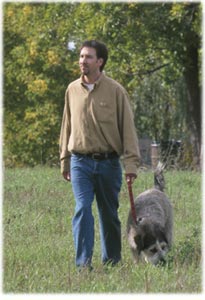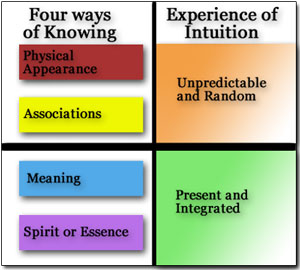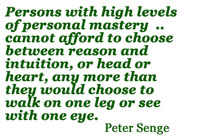The answer to this question is yes and no. Your purest intuitions are always right but those tinged by your own thoughts and emotions may only be partially correct or even completely wrong. With practice, you can learn to assess your intuitive experiences and identify when they are more likely to be right.
Is logic always right?
For some reason we expect more from intuition than we do from logic. Ask yourself if your logic has ever been wrong about anything? Most people would agree that their logic doesn't always prove accurate. But we expect intuition to be perfect, even though we are not skilled in its use. This is magical thinking and intuition is not magic.
While intuition is not always perfect, we can develop our intuitive skills to increase their usefulness. Practice with intuition teaches you how to identify, integrate, apply, and assess your intuitive experiences.
On an interesting note, we don't yet fully understand the mechanism by which true intuition allows us to obtain information. But in the last five years, researchers have discovered chemical reactions that occur in your body during commonly-reported intuitive experiences. Some day scientists may even discover biological distinctions between pure intuition and other phenomena, such as wishful thinking, projection, and imagination.
How do I identify true intuition?
Intuition takes many forms and can include visual imagery, as well as any intuitive sensing in your body--with your ear, or nose, gut, heart or any other way that information arises without the use of logical processes. Most of us have little training in identifying any of these, because Western education methodologies focus primarily on left brain skills. We need to begin by paying attention so we can recognize our intuitive sensing. Then we need to determine if it is true.
One of the most challenging things for us to do is to separate true intuition from wishful thinking (what we hope will happen) or projections (interpreting images through the lens of our own history or ideas.)
 Example of Wishful Thinking. Elaine believed that her intuition had told her that she would be a contestant on a TV game show and began to prepare. When she excitedly went to Los Angeles to try out for the show, she was crushed when she was not chosen. When she examined her behavior later, Elaine realized that it was not true intuition, but her life-long desire to be on TV that was functioning.
Example of Wishful Thinking. Elaine believed that her intuition had told her that she would be a contestant on a TV game show and began to prepare. When she excitedly went to Los Angeles to try out for the show, she was crushed when she was not chosen. When she examined her behavior later, Elaine realized that it was not true intuition, but her life-long desire to be on TV that was functioning.- Example of Projection. John thought that his intuition was telling him that Helen would dump him after three months of dating. Not wanting that to happen, John began to cling to the relationship as the dreaded prediction neared. John's behavior was so odd that Helen began to have doubts about their relationship. Without realizing it, John was projecting onto Helen because his last serious relationship ended when his partner suddenly dropped him.
All of us are full of wishes and fears. When you open to intuitive images, it is important to be aware of how these wishes and fears can confuse your ability to identify true intuition.
What are good methods?
Three methods for identifying true intuition are:
- Tuning into your body
- Focusing or meditation techniques
- Analyzing your images
Tuning into your body
Your body is amazing. Tune into its response when you have an intuition.

People describe feeling the following with true intuition: openness; relaxation; joy; a sense of connection or belonging; lack of doubt; clarity; surprise; awe; excitement; fulfillment; inspiration; or brightness. Naturally, their curiosity is heightened.
- In pure intuitions, you will have a profound sense of knowing. In fact, entire scientific directions and musical pieces have been built upon a pure, split second, intuitive image, for example, the DNA double helix and some Mozart's symphonies.
- Projections, on the other hand, activate very different feelings in the body. Often they are associated with the closing down of the heart, becoming anxious, fearful, or worried. Next time you intuit something, notice what happens in your body. Is your body relaxed and excited all at once? Or, are you more anxious and questioning the validity of your perception?
Of course, if you intuit the potential for a difficult event or outcome, especially if it relates to your health, you will naturally be concerned. Watch these emotions, too. Use your common sense. Get the opinion of a professional. With patience and a centered approach, you will learn in time what is true. - Wishful thinking is a little harder to distinguish from true intuition because it can also be accompanied by a sense of joy and rightness. The differences are subtle. With practice, you will learn that wishful thinking is often accompanied by neediness and a big investment in your image coming true. True intuition is accompanied by the quality of detachment. For example, you might see it as a beautiful outcome, but not feel as though you
have to make it come true.
The dancer, Agnes de Mille, once said, "Bodies never lie." Like an exquisite tuning fork, your intuitive body will tell you the truth. You can learn its language and know to trust it.
Focusing or meditation
Willis Harman, Stanford researcher and President of the Institute for Noetic Sciences, stated, "Most of us are living on the periphery of our lives; intuition invites us into the center."
 Have you ever heard people refer to themselves or others as 'centered' or 'not centered?' Being centered refers to a state where you are relaxed and calm, yet quite alert. This state is less likely to produce intuition clouded by projections or wishful thinking and thus facilitates pure intuition.
Have you ever heard people refer to themselves or others as 'centered' or 'not centered?' Being centered refers to a state where you are relaxed and calm, yet quite alert. This state is less likely to produce intuition clouded by projections or wishful thinking and thus facilitates pure intuition.
Many people have experienced this state without striving to achieve it. For example, some people find that nature calms them. Other people listen to music or talk with a good friend in order to restore their sense of inner peace and balance. There are many ways for people to separate themselves from their emotional responses, projections, or wishful thinking.
Another way to induce a centered state is to focus or meditate. This allows you to develop an observing self-a self that acknowledges your thoughts and emotions without believing that they are you. There two ways to do this, as shown in the examples below.
Both examples concern Sarah, who is worried about doing well at work.
Using the first method, Sarah focuses her attention on a soothing image that helps her create an inner calmness. When her worries arise, she lets them pass-by without responding emotionally or intellectually. This is rather like tuning out TV advertisements that don't interest you. This is how Sarah treats her worries-she is not repressing them or denying their existence, she is simply not allowing them to disturb her calmness.
Using the second method, Sarah creates an inner calmness by focusing on her breath. When worries arise, she examines them from this calm state. She is curious: what is this worry? Where am I feeling it in my body? How important is this worry in the big picture of life? As she repeatedly asks these questions, her worries pass by and Sarah realizes that they are not who she is. She feels an inner state of calm detachment.
Both ways establish the observing self and its capacity to remain calm. Inner calm fosters true intuition and allows it to be easily identified. It is instantaneously relevant to you and beyond you. Pure intuition is non-emotional, although it may fill you with a sense of joy and connection.
Of course, achieving a calm, detached state is challenging for all of us. You might have to explore different techniques to see what works-for some it may be sitting meditation, for others it may be listening to music or walking in nature. You may find it takes quite a bit of practice and even then may be easier at some times than others. But even at the beginning, simply recognizing your emotional state can help you assess if your intuition might be tinged or pure.
Analyzing your images
Since wishful thinking and projection are so filled with your history, your hopes, your ideas, and your wounds, it is important to analyze your images. Ask yourself these types of questions:
- Is this an image or a sensation from my past?
- Did I see, hear, or in some way experience something like this in the movies, on TV, or in a book?
- Does this image have anything to do with my fears or worries?
- How much do I wish that this image would come true?
It is some times useful to write your answers down to this question. Of course, your intuition can use your history to bring legitimate intuitive information to you. Therefore, you can not dismiss all the intuitions that you have which are related to your past. But, it is important to be objective and unemotional when assessing them.
You have nothing to lose by asking yourself questions, keeping a record of the answers, and waiting to assess the results. Remember this: your intuition is not going to go away.
What should I do if intuition gives me conflicting input?
If intuition seems to be giving you conflicting input, the best thing to do is to do nothing. No matter what the issue is, your intuition will stay with you. You can afford to wait for clarity.
In addition, most of the time conflicting input suggests that you are not dealing with pure intuition. Projections and wishful thinking are probably involved. Reflect a little to see if you can identify them.
This is an ideal time for you to analyze the conflicting input deeply. Ask yourself if the different intuitive inputs are related more deeply than it appears on the surface or if the conflict is related to timing rather than other factors.
Why is intuition so unpredictable?
People sometimes wonder if intuition is always right because intuition appears to be so unpredictable. Why does intuition seem so unpredictable?
Patajali, an Indian physician turned sage, suggested one possible answer when he wrote the Yoga Sutras in approximately 200 B.C. Among other things, the book, which was designed to help people develop their mental, physical, and spiritual health and wellbeing, addressed the question: How do people know anything?
 Patanjali described four ways you know something: by (a) its physical appearance, (b) the associations you have with it, (c) the meaning it has for you and (d) its spirit or essence. The way you know also determines how you experience intuition.
Patanjali described four ways you know something: by (a) its physical appearance, (b) the associations you have with it, (c) the meaning it has for you and (d) its spirit or essence. The way you know also determines how you experience intuition.
When your primary modes of knowing are based on (a) the physical or material world and (b) your associations with it, intuition is an occasional guest in your life. Intuition does function at this level, but it is more like a tool that you pick up, or something that is suddenly there or not. If you are working with intuition on these levels, it will seem unpredictable.
When you are leading a fulfilling life, one with meaning for you (level c), intuition can be fully integrated in your life and an equal partner with your logic, if you commit to it. Remember: intuition thrives in meaning and travels on love. When you love your life and its purpose, intuition becomes a way of life. You understand how it functions and know that you can count on intuition's wise and elegant input.
The fourth way-spiritual or essence level knowing-allows you to be one with or resonant with that which you want to know. At this level there is no separation between yourself and the other, so direct knowledge is available.
 In summary
In summary
Intuition in its purest form is always right. Therefore, it is worth cultivating.
There are many things can help you identify your true intuition from other imagery that you may experience. To begin, listen to your body and the signals it is giving. Try also to develop a focusing practice that allows you to achieve a calm, detached state where you can better identify what is going on. And always examine your intuitive images to see if you recognize wishful thinking or projections in them.
© 2006 Charlson Meadows, used with permission.
Goldstein, Joseph. (1987). The Experience of Insight, Shambhala, Boston & London.
Iyengar, BKS. (1993). Light on the Yoga Sutras of Patanjali. Thorsons, HarperCollins Publishers, London.
Palmer, Helen, (Ed.). (1998). Inner Knowing: Consciousness, Creativity, Insight, and Intuition. Jeremy P. Tarcher/Putnam, New York.
Vaughan, Frances E.( 1997). Awakening Intuition. Anchor Books, Garden City, NY.




